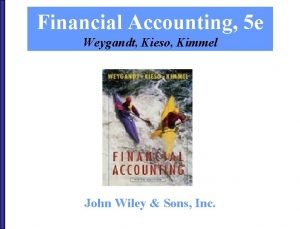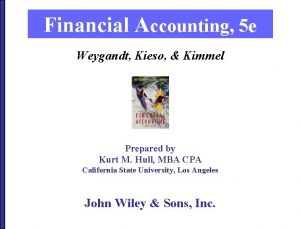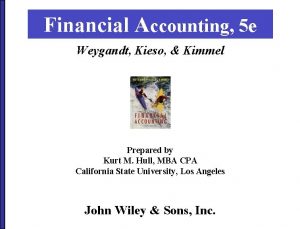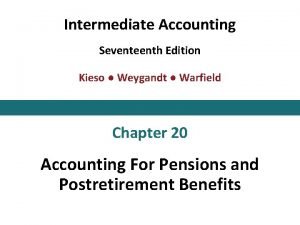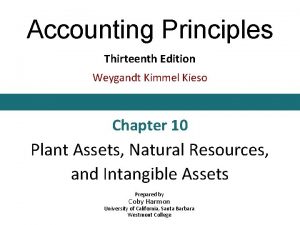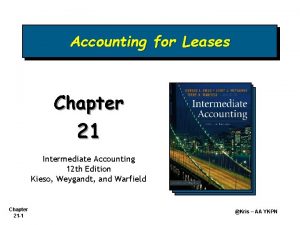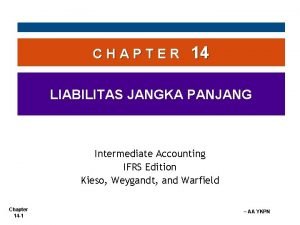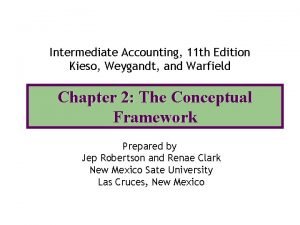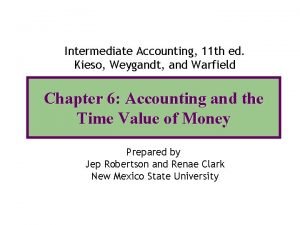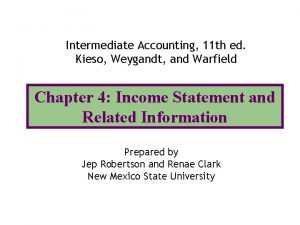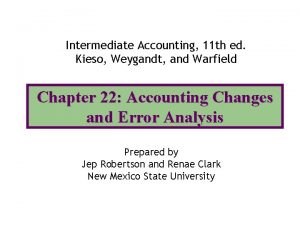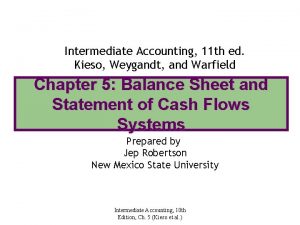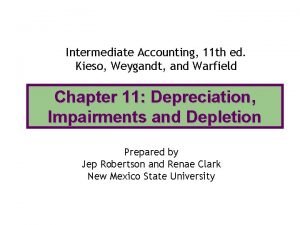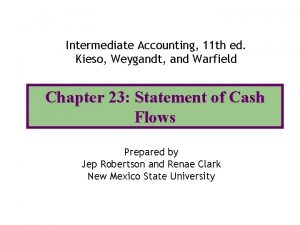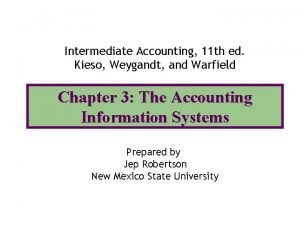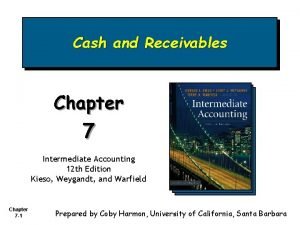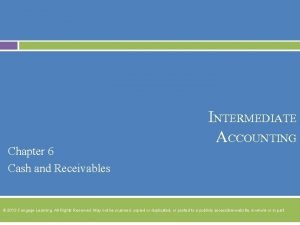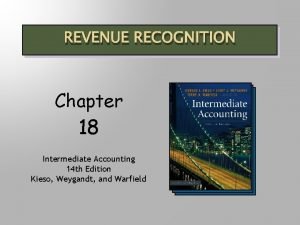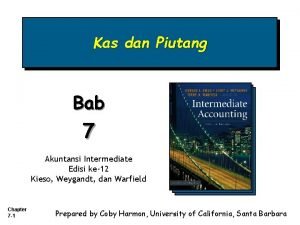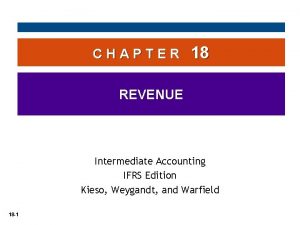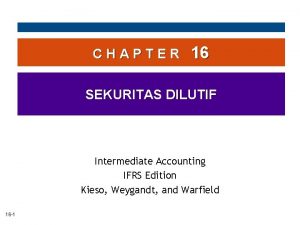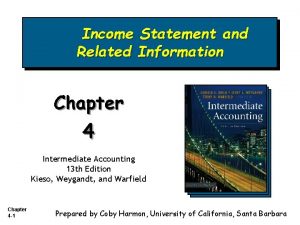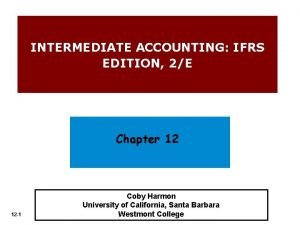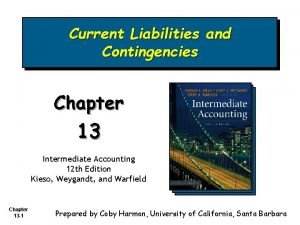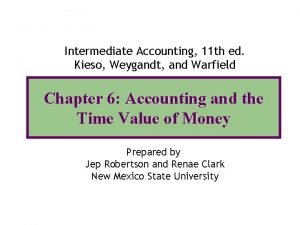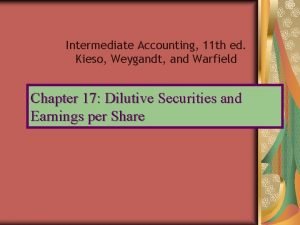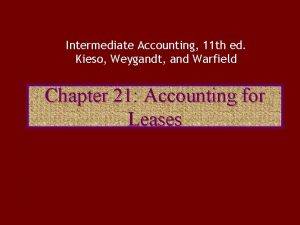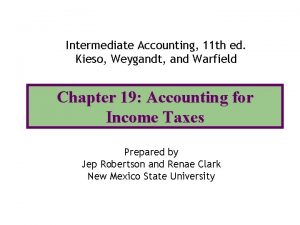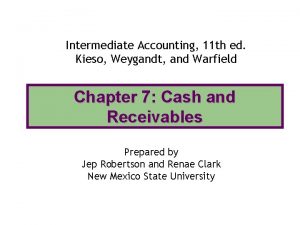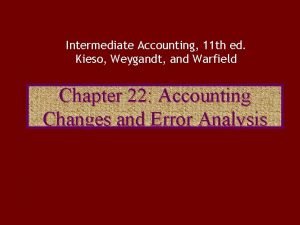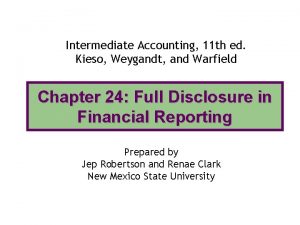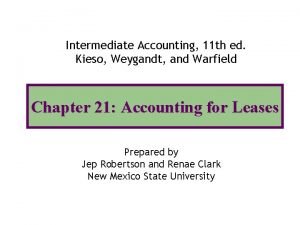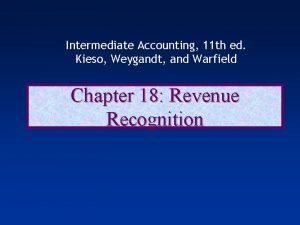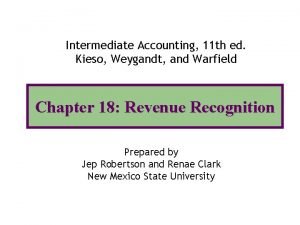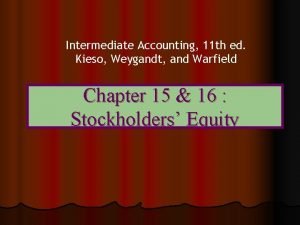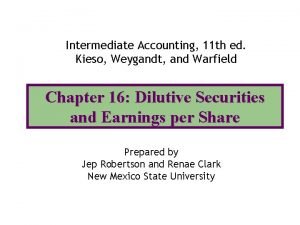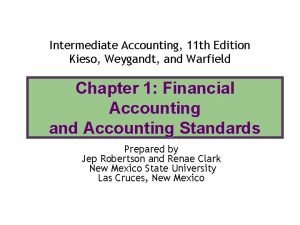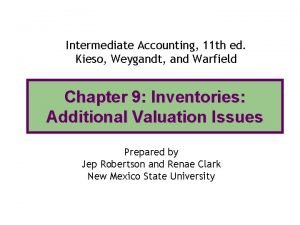Intermediate Accounting 11 th ed Kieso Weygandt and




























- Slides: 28

Intermediate Accounting, 11 th ed. Kieso, Weygandt, and Warfield Chapter 8: Valuation of Inventories: A Cost Basis Approach Prepared by Jep Robertson and Renae Clark New Mexico State University Intermediate Accounting, 10 th Edition, Ch. 8 (Kieso et al. )

Chapter 8: Valuation of Inventories: A Cost Basis Approach After studying this chapter, you should be able to: 1. Identify major classifications of inventory. 2. Distinguish between perpetual and periodic inventory systems. 3. Identify the effects of inventory errors on the financial statements. 4. Identify the items that should be included as inventory cost. 10/30/2020 Intermediate Accounting, 10 th Edition, Ch. 8 (Kieso et al. ) 2

Chapter 8: Valuation of Inventories: A Cost Basis Approach 5. Describe and compare the flow assumptions used in accounting for inventories. 6. Explain the significance and use of a LIFO reserve. 7. Explain the effect of LIFO liquidations. 8. Explain the dollar-value LIFO method. 9. Identify the major advantages and disadvantages of LIFO. 10. Identify the. Intermediate reasons why a given inventory 3 10/30/2020 Accounting, 10 th Edition, Ch. 8 (Kieso et al. ) method is selected.

Inventory Classification Inventory consists of: 1. Finished goods held for sale in the ordinary course of business. 2. Goods held or consumed in the production of finished goods. 10/30/2020 Intermediate Accounting, 10 th Edition, Ch. 8 (Kieso et al. ) 4

Inventory Cost Flows Merchandising Operations Merchandise Inventory Purchases C/G/Sold Cost of goods sold $$$ 10/30/2020 Intermediate Accounting, 10 th Edition, Ch. 8 (Kieso et al. ) 5

Flow of Costs through Manufacturing and Merchandising Companies 10/30/2020 Intermediate Accounting, 10 th Edition, Ch. 8 (Kieso et al. ) 6

Inventory Control Inventory control is important for: 1. Ensuring availability of inventory items 2. Preventing excessive accumulation of inventory items The perpetual system maintains a continuous record of inventory changes The periodic system updates inventory records only periodically 10/30/2020 Intermediate Accounting, 10 th Edition, Ch. 8 (Kieso et al. ) 7

Inventory Systems Perpetual Method • Purchases are debited to Purchases account. • Freight-in, Purch. R & A and Purch. Disc. are recorded in their respective accounts. • COGS is computed only periodically: COGAS - Ending Inventory COGS Intermediate Accounting, 10 th 8 • Purchases are debited to Inventory account • Freight-in, Purch. R & A and Purch. Disc. are recorded in Inventory account. • Debit COGS and credit Inventory account for each sale. 10/30/2020 Periodic Method Edition, Ch. 8 (Kieso et al. )

Items to be Included in Inventory Legal title to goods typically determines inclusion. The following goods are included in “seller’s” inventory: 1. 2. 3. 4. 5. Goods in transit (FOB Destination) Goods on consignment with consignee Goods, sold under buy back agreements Goods, sold with high rates of return Installment sales (if bad debts can not be estimated) 10/30/2020 Intermediate Accounting, 10 th Edition, Ch. 8 (Kieso et al. ) 9

Guidelines for Determining Ownership 10/30/2020 Intermediate Accounting, 10 th Edition, Ch. 8 (Kieso et al. ) 10

Effect of Inventory Errors Error in Ending Inventory Effect on Income Items Effect on Balance sheet Items Understated COGS (over) Net income (under) Inventory (under) Retained Earn (under) Overstated C/G/sold (under) Net income (over) Inventory (over) Retained Earn (over) 10/30/2020 Intermediate Accounting, 10 th Edition, Ch. 8 (Kieso et al. ) 11

Costs Included in Inventory Generally accounted for on a cost basis. • Product costs are “inventoriable” costs, whereas • Period costs are not inventoriable costs 10/30/2020 Intermediate Accounting, 10 th Edition, Ch. 8 (Kieso et al. ) 12

Cost Flow Assumptions The objective is to most clearly reflect periodic income. Cost flow assumptions need not be consistent with physical flow of goods. The cost flow assumptions are: 1 2 3 4 10/30/2020 Specific identification Average cost First-in, first-out (FIFO) and Last-in, first-out (LIFO) Intermediate Accounting, 10 th Edition, Ch. 8 (Kieso et al. ) 13

Cost Flow Assumptions: Example Susieworld reports the following transactions for 2004: Date Purchases Purchase Cost May 12 100 units $1, 000 Aug 14 200 units 2, 200 Sep 18 120 units 1, 800 420 units $5, 000 On December 31, the company had 20 units on hand uses the periodic inventory system. What are the cost of goods sold and the cost of ending inventory? 10/30/2020 Intermediate Accounting, 10 th Edition, Ch. 8 (Kieso et al. ) 14

Average (Weighted) Method Given Data: Date May 12 Aug 14 Sep 18 Purchases 100 units 200 units 120 units 420 units Cost $1, 000 $2, 200 $1, 800 $5, 000 Steps: 1. Calculate per unit average cost: $5, 000/420 = $11. 905 2. Apply this per unit average cost to units sold to get COGS: 400 x $11. 905 = $4, 762 3. Apply the per unit average cost to units remaining in inventory to determine Ending inventory: 20 x $11. 91 = $238 10/30/2020 Intermediate Accounting, 10 th 15 Edition, Ch. 8 (Kieso et al. )

First-In, First-Out (FIFO) Method Given data: Date Purchases May 12 100 units @ $10 Aug 14 200 units @ $11 Sep 18 120 units @ $15 420 Cost $1, 000 $2, 200 $1, 800 $5, 000 Cost of $1, 000 $2, 200 $1, 500 $4, 700 goods sold (FIFO) (100 sold) (200 sold) (100 sold; 20 end inv) Cost of goods available Cost of goods sold $4, 700 $5, 000 Ending inventory 20 * $15 = $300 10/30/2020 Intermediate Accounting, 10 th Edition, Ch. 8 (Kieso et al. ) 16

Last-In, First-Out (LIFO) Method Given data: Date Purchases May 12 100 units @ $10 Aug 14 200 units @ $11 Sep 18 120 units @ $15 420 Cost $1, 000 $2, 200 $1, 800 $5, 000 Cost of goods sold (LIFO) $ 800 (80 sold; 20, end inv) $2, 200 (200 sold) $1, 800 (120 sold) $4, 800 Cost of goods available Cost of goods sold $4, 800 $5, 000 Ending inventory 20 * $10 = $200 10/30/2020 Intermediate Accounting, 10 th Edition, Ch. 8 (Kieso et al. ) 17

Cost Flow Assumptions: Notes • The ending inventory in units is the same in all three methods: the cost is different. • The cost of goods sold and the cost of ending inventory are different, but • The cost of goods available is the same in all three methods. • LIFO would result in the smallest reported net income (with rising prices). 10/30/2020 Intermediate Accounting, 10 th Edition, Ch. 8 (Kieso et al. ) 18

LIFO Reserve (Allowance) account is used, when: LIFO is used for external reporting and a non-LIFO basis is used for internal reporting. An Allowance to Reduce Inventory to LIFO is used to reduce the cost to a LIFO basis. 10/30/2020 Intermediate Accounting, 10 th Edition, Ch. 8 (Kieso et al. ) 19

LIFO Reserve: Example Jeppo Inc reports the following balances: Inventory (FIFO basis) on Dec 31, 2004: Inventory (LIFO basis) on Dec 31, 2004: $50, 000 $20, 000 Adjust the cost of ending inventory to the LIFO basis Cost of goods sold Dr. $30, 000 Allowance to Reduce Inventory to LIFO Cr. $30, 000 Balance Sheet (Assets): Inventory (FIFO) less: Allowance to Reduce Inventory 10/30/2020 Intermediate Accounting, 10 th Inventory (LIFO) basis Edition, Ch. 8 (Kieso et al. ) $50, 000 ($30, 000) 20 $20, 000

LIFO Layers Under the LIFO approach, a business may build up layers of inventory from prior periods. A layer liquidation occurs, when: • Earlier costs are matched against current sales. • Such matching results in distorted income. 10/30/2020 Intermediate Accounting, 10 th Edition, Ch. 8 (Kieso et al. ) 21

Methods to Alleviate Layer Liquidation Problems Use the specific goods pooled LIFO approach: a pool is a combination of similar items. • reductions in one item, compensated by increases in other items. Use dollar-value LIFO where: • changes in pools are determined in terms of dollars, not quantities. 10/30/2020 Intermediate Accounting, 10 th Edition, Ch. 8 (Kieso et al. ) 22

Dollar Value LIFO: Example Given: Base layer (Dec 31, 2003): $20, 000 Inventory (current prices) on Dec 31, 2004: $26, 400 Prices increased 20% during 2004. Determine dollar value LIFO at Dec 31, 2004 10/30/2020 Intermediate Accounting, 10 th Edition, Ch. 8 (Kieso et al. ) 23

Dollar Value LIFO: Example Price increase, 20% Dec 31, 2003 At base $: $22, 000 Dec 31, 200 $26, 400 / 1. 20 Net increase at base $: $22, 000 less $2, 000 * 1. 20 $20, 000 10/30/2020 At EOY prices: $26, 400 Restate at current $: $2, 400 Intermediate Accounting, 10 th added) (layer Edition, Ch. 8 (Kieso et al. ) Dollar value LIFO Inventory $20, 000 plus $2, 400 = 24 $22, 400

Dollar Value LIFO: Notes When the ending inventory (at base year prices) is less than the beginning inventory (at base year prices): • the decrease must be subtracted from the most recently added layer. • Once a layer is eliminated (peeled off), it cannot be rebuilt. 10/30/2020 Intermediate Accounting, 10 th Edition, Ch. 8 (Kieso et al. ) 25

Advantages of LIFO Method • LIFO matches more recent costs with current revenues. • With increasing prices, LIFO yields the lowest taxable income (assuming inventory does not decrease). • With reduced taxes, cash flow is improved. • Under LIFO, the need to write down inventory to market is lower. 10/30/2020 Intermediate Accounting, 10 th Edition, Ch. 8 (Kieso et al. ) 26

Disadvantages of LIFO Method • LIFO does not approximate the physical flow of goods except in special situations. • LIFO yields the lowest net income and therefore reduced earnings (when prices rise). • Under LIFO, the ending inventory is understated relative to current costs. • LIFO involuntary liquidation may result in income that is detrimental from a tax view. • LIFO may cause poor buying habits (because 10/30/2020 Intermediate Accounting, 10 th 27 of the layer liquidation problem). Edition, Ch. 8 (Kieso et al. )

COPYRIGHT Copyright © 2004 John Wiley & Sons, Inc. All rights reserved. Reproduction or translation of this work beyond that permitted in Section 117 of the 1976 United States Copyright Act without the express written permission of the copyright owner is unlawful. Request for further information should be addressed to the Permissions Department, John Wiley & Sons, Inc. The purchaser may make back-up copies for his/her own use only and not for distribution or resale. The Publisher assumes no responsibility for errors, omissions, or damages, caused by the use of these programs or from the use of the information contained herein. 10/30/2020 Intermediate Accounting, 10 th Edition, Ch. 8 (Kieso et al. ) 28
 Financial and managerial accounting weygandt kimmel kieso
Financial and managerial accounting weygandt kimmel kieso Kimmel accounting tools 5e
Kimmel accounting tools 5e Kimmel weygandt kieso accounting 5th edition
Kimmel weygandt kieso accounting 5th edition Kimmel weygandt kieso accounting 5th edition
Kimmel weygandt kieso accounting 5th edition Kieso weygandt warfield
Kieso weygandt warfield Weygandt kimmel kieso
Weygandt kimmel kieso Chapter 21 accounting for leases kieso terjemahan
Chapter 21 accounting for leases kieso terjemahan Chapter 14 intermediate accounting kieso bahasa indonesia
Chapter 14 intermediate accounting kieso bahasa indonesia Intermediate accounting kieso
Intermediate accounting kieso Intermediate accounting kieso
Intermediate accounting kieso Intermediate accounting kieso
Intermediate accounting kieso Intermediate accounting kieso
Intermediate accounting kieso Intermediate accounting
Intermediate accounting Intermediate accounting kieso
Intermediate accounting kieso Intermediate accounting kieso
Intermediate accounting kieso Intermediate accounting kieso
Intermediate accounting kieso Intermediate accounting chapter 17 investments pdf
Intermediate accounting chapter 17 investments pdf Cash and receivables intermediate accounting
Cash and receivables intermediate accounting Cash and receivables intermediate accounting
Cash and receivables intermediate accounting Chapter 18 revenue recognition solutions
Chapter 18 revenue recognition solutions Chapter 7 kas dan piutang
Chapter 7 kas dan piutang Chapter 18 revenue recognition kieso
Chapter 18 revenue recognition kieso Kieso chapter 16 bahasa indonesia
Kieso chapter 16 bahasa indonesia Income statement kieso
Income statement kieso Book value per ordinary share
Book value per ordinary share Patent impairment
Patent impairment Current liabilities and contingencies chapter 13
Current liabilities and contingencies chapter 13 Types of leases
Types of leases Types of leases
Types of leases

